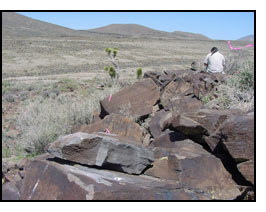Basalt Lowlands - Site 3
 This site is located on a low basalt knob on a grassy plateau. There are
seventeen rock art panels at the site, of which all but one are on the northwest
side of the outcrop. Several milling slicks (seed grinding surfaces) are
clustered below the knob both to the north and south.
This site is located on a low basalt knob on a grassy plateau. There are
seventeen rock art panels at the site, of which all but one are on the northwest
side of the outcrop. Several milling slicks (seed grinding surfaces) are
clustered below the knob both to the north and south.
The most complex panel has eleven individual elements or figures, though most have only one or two. Six panels have only abstract designs, four have only representational ones, two have only scratched designs, four have both abstract and representational elements, and one has all three kinds. Overall, representational designs are most numerous, and these are sheep (32) or simple depictions of humans (2), one of which appears to be using a bow and arrow. Of the abstract designs (23), no particular type is prevalent; rather, various types are represented by only one or two examples -- shields, grids, rakes, dots, and so forth. Four scratched designs also are present. One of these consists of vertical parallel lines; the three others are uneven and asymmetric cross-hatched designs. Individual variation among sheep designs is best shown by Panel 9. Different shapes and techniques were used to draw their bodies. Leg placement and style also varies, and head and horn configurations differ from one element to the next. A lance through the hindquarters of one sheep might be cited as evidence that hunting magic was practiced. Yet the sheep on the far right has human-like qualities, and might be interpreted as depicting the transformation of a human into a bighorn sheep spirit helper. Perhaps the most distinctive abstract element at the site is the shield that constitutes Panel 12, while Panel 8 is more typical of the abstract panels. Panel 1 is a particularly good example where abstract and representational elements co-occur. The former is a rectangular shield, while the latter include one simple anthropomorph and one sheep with horns curved over the back and a shaft (a spear or lance?) through the torso. The scratched design on Panel 10 is representative of the unstructured cross-hatching that occurs on several panels. This panel also demonstrates how superpositioning and different degrees of weathering provide clues about the rock art's age and chronology. A faint abstract design (a complex cluster of circles) occurs to the right of, and is partly overlaid by, the scratched design. The abstract design is difficult to see because it has weathered considerably since it was made, in contrast to the scratched design. We can readily conclude that the scratched design is considerably more recent than the underlying, faint abstract design on this panel.
The site map below shows the location of rock art panels as yellow dots. Click on any of the dots to see a photo of the panel at that location.
|
